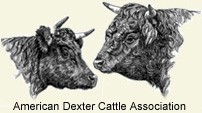Dexter cattle are from the southern part of Ireland where
they were bred by small ranches and roamed, almost wild, among the local
mountains.
It is believed that Dexter cattle were developed as a cross between
Kerry cattle and some other breed, perhaps Devon Cattle. It is also believed
that a "Mr. Dexter," who was agent to Lord Hawarden, is responsible for
developing the Dexter breed.
There are two varieties of Dexter Cattle, short legged and
long legged, also referred to as Kerry type. Both types are about equal up for Milk
and beef production. The same dam and sire may produce a short legged calf in
one mating and a long legged calf the next.
Most Dexters are solid black. Red or dun colored are less
common. Horns on cows are fine and curved forward. Bulls' horns are thick,
solid, and slightly curved at the tips. Their distinctive heads are short and
wide between the eyes, with straight sides.
Dexter milking cows can produce more milk for its weight
than any other breed. The daily yield averages 1 1/2 to 2 1/2 gallons with
butterfat content of 4 to 5 percent. Sometimes they up to one quart cream per
gallon. The cream can be skimmed for butter or ice cream.
Dexter Beef Cattle mature in 18 months and result in small
cuts of high-quality lean meat, graded choice, with little waste. The
expectable average dress out is 50 to 60 percent and the beef is slightly
darker red than that of other breeds.
In recent years there has been a worldwide surge of interest
in Dexter cattle. They are gentle, hardy and easy-to-handle animals and one of
the world's smallest bovines. They require less pasture and feed than other
breeds. They thrive in hot as well as cold climates and do well outdoors year
round, needing only a windbreak, shelter and fresh water. Fertility is high and
calves are dropped in the field without difficulty. They are dual purpose,
being raised for both milk and meat.


